Imagine if you had the power to produce many engrossing, high-quality blog posts on any topic under the sun within seconds. Seems like a lofty dream, right? Well, welcome to the real world of AI-generated articles! The astonishing advancement in Artificial Intelligence technology has made what was once a fantasy into reality.
AI is no longer confined to science fiction or high-tech laboratories; it’s also turning heads in the content marketing world. It is arguably one of the most game-changing tools for creating quick and quality-driven articles that contribute significantly to your repertoire of online content.
What is AI Article Writing?
In the simplest terms, AI article writing refers to using Artificial Intelligence to create written content. Now, let me explain this a bit further.
With the significant advances in technology we’re seeing these days, it’s no longer surprising that AI has penetrated into realms previously dominated by humans, including content creation. AI algorithms, backed by machine learning and natural language processing capabilities, are now being programmed to grasp human languages and norms of written communication.
The result? The impressive ability of AI to write articles just like a human writer would, or perhaps even better. It’s important to distinguish this from simple spinning or rephrasing tools, though; what I’m talking about here is much more advanced than mere sentence restructuring.
AI article writing marks an evolution from traditional methods where you’d have to spend hours researching, structuring your thoughts, and manually typing your words. This novelty revolves around leveraging machine intelligence to automate writing tasks and develop original pieces of text without human input beyond setting parameters (topics, keywords, length, etc.).
It’s literally as if the AI writes for you. Just remember that while writing articles with AI seems like an exciting proposition for many businesses today, it comes with its own challenges and considerations, which I’ll explore later in this post.
What are AI-generated Articles?
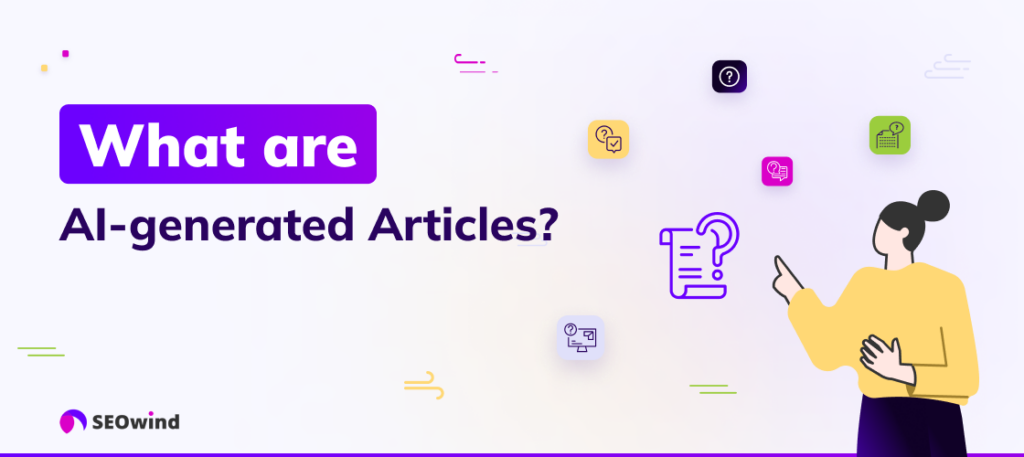
When we talk about AI-generated articles, we’re referring to pieces authored mainly (or entirely) by software applications designed specially for this purpose. The good news is there is already a range of high-quality AI writer online tools capable of crafting engaging content across different formats, from blog posts to news stories to product descriptions.
When used correctly, these futuristic tech products can help generate quality content in seconds! Trust me when I say that AI automatic writing isn’t some passing fad. Rather, it signifies a revolution in the world of article writing. It’s among emerging technologies shaping the future of digital content. So, buckle up as we delve deeper into this exciting new frontier!
Advantages of AI-Generated Articles
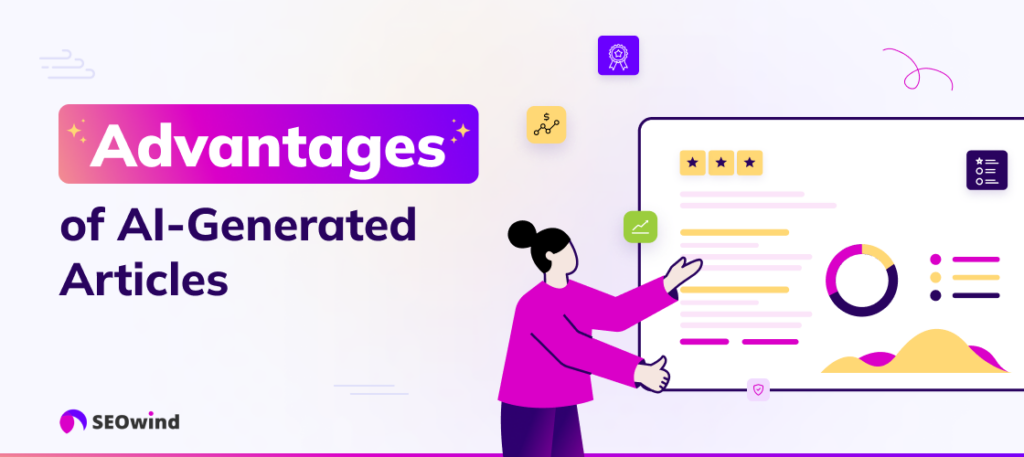
Imagine a scenario where you could get quality content in seconds with little to no strain on your time or resources. This is what revolutionary AI-generated articles bring to the table, and it’s fundamentally transforming how businesses approach their content creation.
Unmatched Speed and Volume
One of the standout advantages of using AI-generated articles is speed. Traditional human writers can spend hours, possibly even days, researching and writing an article. On the other hand, an AI that writes articles might draft similar, if not identical, content within a fraction of this time.
Cost Savings
Cost savings are another decisive advantage. Utilizing AI for content creation reduces costs associated with outsourcing work to freelance writers or maintaining a full-time staff for content development.
Flexibility
AI provides flexibility across multiple genres and industries. Whether you need blog posts about tech innovations or product descriptions for your e-commerce site, AI has you covered!
A Steady Stream of Content
Artificial Intelligence doesn’t sleep or take breaks; it keeps pumping out quality articles round-the-clock. This constant supply regularly fills your digital platforms with fresh content, which gives readers another reason to return.
Customization
AI allows personalization based on data insights about the reader’s preferences. Writing programs can effortlessly tailor articles to target specific audience segments, improving engagement rates significantly.
In this era of Artificial Intelligence, these solutions bolster productivity more than anyone ever imagined possible. With all these benefits rolled into one package – speed, cost-effectiveness, versatility, reliability, and customization – it’s hard not to see why so many are turning towards AI automatic writing tools as their go-to choice for creating compelling digital narratives.
Types of AI-Generated Articles
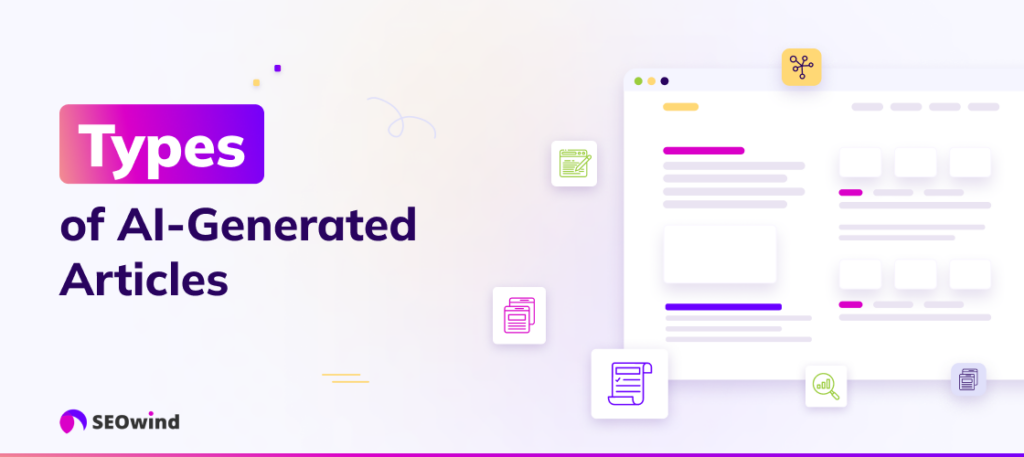
AI-generated articles are not confined to a single genre or category. They permeate various sections in the realm of digital and content marketing, which includes, but isn’t limited to, news articles, blog posts, product descriptions, and press releases.
News Articles
The first port we’ll dock at on our exploration journey is the terrain of news articles. Neural networks have become adept at churning out brief, factual, and timely news pieces. Take, for instance, how AI quickly centralizes and synthesizes data from multiple sources and then uses this information to write articles. This mechanism is handy for financial reports or sports scores wherein information needs to be posted as soon as possible.
Blog Posts
Moving onwards from newsrooms, let’s venture into blogging, where creativity meets consistency. It’s pretty compelling how machine learning algorithms can crawl through piles of data to assess patterns before producing coherent sentences that appeal to your niche audience base. Artificial Intelligence can compose engaging, optimized blog posts tailored to your specific requirements via iterations based on feedback.
Product Descriptions
Now, let’s plunge into the commercial sector—eCommerce sites, to be exact— that heavily rely on articulate yet compelling product descriptions, an integral part of strategic marketing efforts. An AI writing tool presents a silver lining by crafting error-free, appealing descriptions that swiftly spotlight each tiny detail about the products in question. The result is a high-quality copy produced in seconds that resonates with potential customers’ wants and needs.
Press Releases
Lastly, is the sphere of public relations entrenched deeply in press releases. This format requires an artful balance between conveying critical company updates while maintaining the attention-grabbing brevity that journalists appreciate. Leveraging tools like “AI writes for you,” businesses enhance their prospects by delivering precise information speedily without hindering sensitivity towards the all-important human touch. This facet is insisted upon even amidst principles of AI automatic writing operation.
Top 3 AI Article Writing Tools
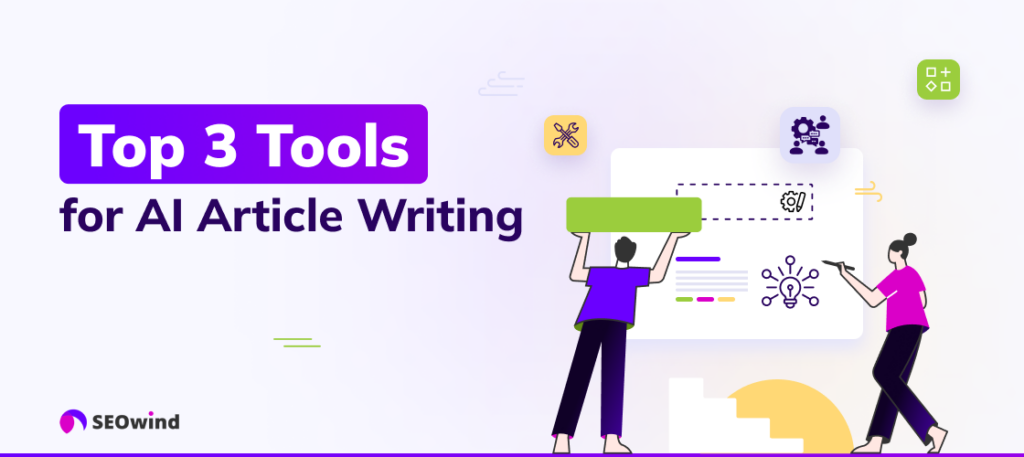
Numerous advanced AI writing tools have emerged in recent years. Their applications vary from content creation and optimization to their use as resourceful aids for writers and marketers. Thus, we plunge into the expansive world of top AI-assisted writing tools.
SEOwind
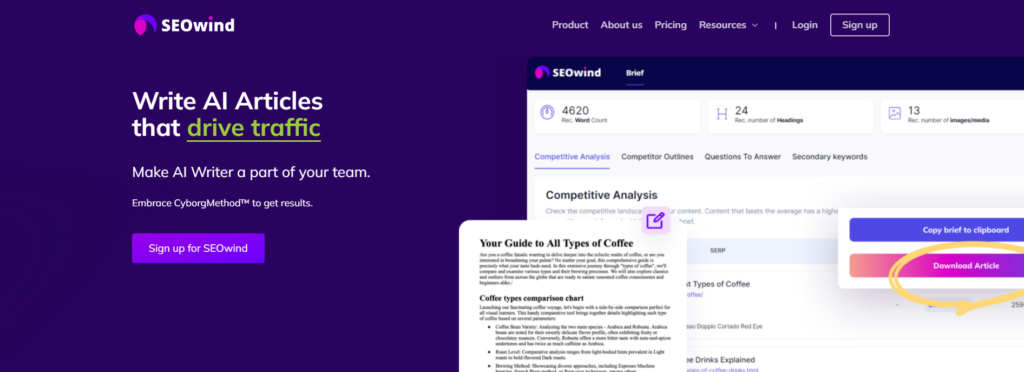
First on our list is SEOwind. This high-performing software stands out when it comes to rapidly generating articles with high SEO value. SEOwind is my go-to tool because it can leverage machine learning algorithms that adequately understand user topics, creating deeply researched and highly readable content.
Additionally, it possesses an intuitive design that simplifies user navigation. For bloggers and website owners constantly struggling with keyword optimization, this tool presents a unique solution: detailed suggestions of relevant keywords integrated effortlessly into your articles.
Jasper

Another notable mention is Jasper. It’s an excellent choice if you’re focused on creating compelling long-form content infused with creativity, such as blog posts or eBooks. This AI assistant also empowers you to maintain your brand voice consistently across every written asset while saving precious time by deploying robust automation!
Writesonic

Last but certainly not least, let’s look into Writesonic, which is renowned for its versatility across various forms of content. Whether you need punchy ad copies, converted landing pages, or engaging blog posts, this tool handles them all! Just supply some basics about what you wish to communicate and watch it whip up engaging articles in no time!
Writesonic embraces AI technology by utilizing a library of pre-designed templates curated explicitly for different industries to provide coherent outlines that ensure succinct and logical content. Moreover, it also supports up to 20 languages, making it an indispensable feature for those catering to multicultural audiences.
To sum up, these three tools – SEOwind, Jasper, and Writesonic – are among the frontrunners in the world of AI writing tools. Each delivers unique strengths worth considering. Selection ultimately depends on your specific needs as a writer or business entity. Therefore, consider what’s most important to you. An SEO-focused tool like SEOwind might appeal more than Jasper, which leans towards rich storytelling abilities. Alternatively, you may prefer a one-stop solution like Writesonic that caters to broader needs across numerous content types.
How to Get Started with AI-Generated Articles

Embarking on the exciting journey of leveraging AI for content creation may initially seem intimidating. But, let me assure you, it’s simpler than anticipated once you follow these logical steps:
- Identify your requirements: Before immersing yourself in the world of AI-generated articles, take a moment to consider what exactly you need from a tool. Are you seeking to create engaging blog posts? Or are comprehensive product descriptions your primary focus? Reflect on what kind of content will best serve your brand.
- Choose the right tool: After identifying your goals, the next step is finding an AI-writing tool that suits them. SEOwind excels in generating SEO-oriented articles, while Writesonic shines when producing ad and marketing copy. Spend some time researching different tools. Remember, my goal is to offer a fantastic foundation for this exploration.
- Trial runs and assessments: Most services come with trial runs or demos, allowing you to assess their capabilities before fully investing. Use this chance to evaluate how well these AI-generated articles align with your tone, style, and objectives.
- Keep the human touch intact: Irrespective of how sophisticated an AI-writing algorithm is, maintaining the human touch within your content is pivotal for retaining authenticity and personal connection with readers.
- Continuous Improvement: Understandably, only some pieces churned out by an automatic writing tool will be perfect immediately! Continuous refinement becomes imperative so feedback loops can optimize successive iterations over time.
In essence, initiating your path into using ‘AI writes article’ software isn’t as daunting once broken down into manageable stages like above. It’s quite similar to traditional writing strategies, just more futuristic!
Bear in mind that every milestone reached brings its own set of challenges; that’s merely part of the growth trajectory. The key to successfully integrating AI-generated articles lies in perseverance, constant vigilance, and an indomitable spirit of innovation. Get started yourself to realize first-hand the incredible opportunities it can unlock. You might be pleasantly surprised!
How to Optimize Your Content with an AI Article Writer

As a content creator, continuously striving towards optimizing your outputs is crucial. An AI writer online can be of immense help here, and I will elucidate how.
Step 1: Identify Keywords
While AI tools can write articles for you automatically, you must provide them with strategic guidance. Start by selecting relevant keywords for your content. This is a critical component in search engine optimization (SEO) and affects the visibility of your article on search engines.
Step 2: Guide Your AI Tool
Even as powerful as AI-generated articles may be, they still need human intervention to ensure quality. Offering clear instructions while setting up your AI tool will improve results. Directly communicate what kind of text you want the tool to generate. Should it be formally toned or written informally? Should it include statistics or rely solely on explanations?
Step 3: Leverage Artificial Intelligence
Impressively enough, an advanced tool like SEOwind exhibits deep learning abilities that allow it to compose readable passages and strategize its writings based on data inputted into its algorithm. Therefore, ensure smooth transitions throughout the text by allowing AI automatic writing capabilities full rein within your given guidelines.
Step 4: Review and Refine
Revise the AI-generated article. Replace overly complex phrases within sentences, making them easy to read and grammatically accurate while preserving their intended meanings.
Scrupulously integrating these steps when using an AI article writer will result in optimized, high-quality posts that suit the preferences of readers and search engines alike!
Use Cases for AI-Generated Articles
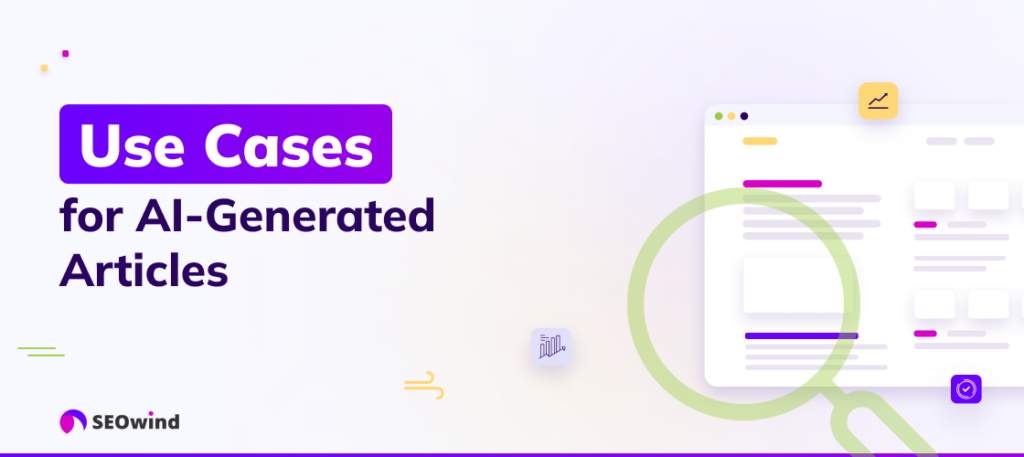
Artificial Intelligence has revolutionized the content creation industry, lending its prowess to various applications. In this section, let’s delve into some common uses of AI-generated articles that aid in quick content production and promise high-quality output.
Content Marketing
Businesses worldwide are leveraging the power of AI writes for you applications to feed their ever-hungry blog posts and social media channels. With an ability to swiftly produce topical, fresh, and keyword-rich articles, these apps have proven to be game-changers in executing successful content marketing strategies.
eCommerce Product Descriptions
With millions of products on offer on any online marketplace at a given time, drafting unique product descriptions can be insurmountably laborious. But guess what? With an online writing tool, eCommerce businesses can create compelling and accurate product descriptions in seconds.
News Reporting
Keeping pace with rapidly changing global events is undeniably strenuous for human writers. Thankfully, news companies are easing this challenge by letting AI write articles about occurrences in near real-time.
Educational Resources
Educational websites and knowledge repositories use AI tools to generate informative and easy-to-understand resources promptly. It’s no surprise that when your aim is educating a broad audience, relying on Artificial Intelligence proves productive!
Customized Emails & Notifications
Targeted marketing demands a thorough understanding of customer behavior and preferences, which AI excels at! Businesses use AI automatic writing features to draft personalized emails or notifications aimed at engaging customers more effectively.
Based on this, it’s clear that whether creating SEO-optimized blog posts or crafting fascinating product descriptions, AI-generated articles pave the way for various applications while speedily ensuring quality content production.
AI-Generated Articles vs. Human-Written Articles
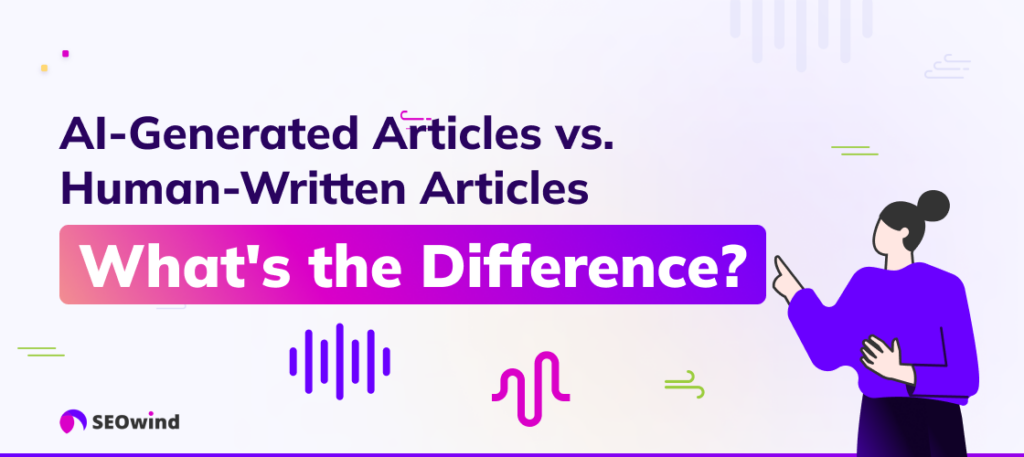
It’s tempting to compare AI-generated articles to those written by humans and question which has the upper hand. In truth, each approach offers a unique set of capabilities.
Speed
First, let’s focus on some areas in which Artificial Intelligence shines. For one, there is the sheer speed at which AI can write articles. AI article-writing platforms can produce numerous pieces of content within seconds. That’s almost as fast as turning on your computer! Producing such quantity manually would consume invaluable hours.
Consistency
AI-driven tools also deliver impressive consistency when generating content. Unlike human writers who might have ‘off’ days or periods of decreased productivity due to multiple factors like burnout or fatigue, AI keeps churning out quality content devoid of emotional influence or performance fluctuation.
Data analysis capabilities
Nothing beats an AI that writes articles when it comes to handling vast data sets and integrating them into content creation. Its capacity for number crunching is nearly limitless, making it excellent for generating financial reports, sports recaps, or any report requiring substantial data processing.
Yet despite these advantages, human writers are not obsolete. While AI solutions effectively gather information and present it logically and clearly within predefined tracks, they must catch up when thrown off course.
Storytelling
Humans excel at storytelling, a classic attribute computers have not yet mastered. This ability allows us to connect emotionally with readers through our words—craft stories that evoke laughter, tears, and inspiration—something no machine can replicate convincingly yet.
Another distinct advantage we possess over AI is our ability to understand and respect cultural contexts and slang expressions better than current versions of AI. Although algorithms are being designed to be more sensitive to this element of communication, attaining complete cultural contextual understanding remains a grand challenge in AI content development.
Perhaps the secret lies in the fact that both methods serve unique purposes and can complement each other well. While AI can be employed for the more factual, data-heavy aspects or bulk content production, human oversight can shine through where creativity, resonance with readers, and maintenance of brand persona are crucial. As a savvy content creator, making the most of both worlds could be your key to outstanding output.
Common Challenges of Writing with an AI Article Writer
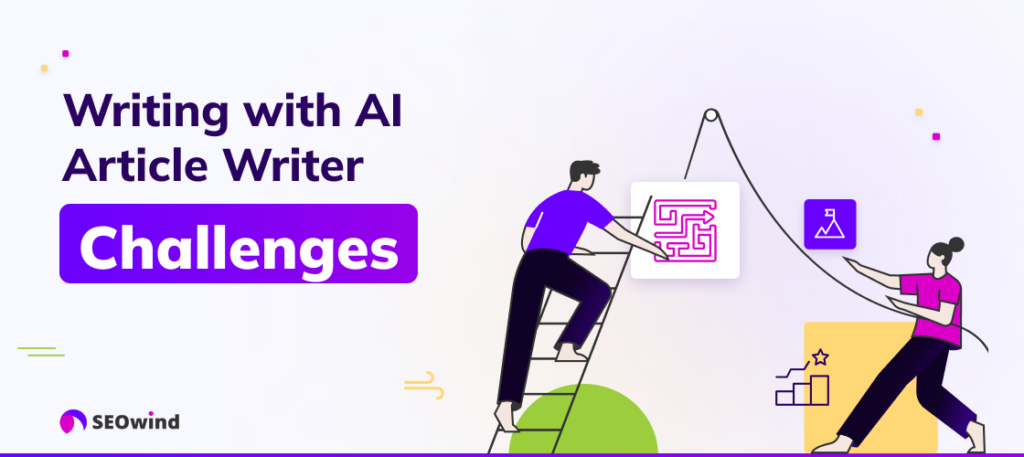
Artificial Intelligence, undeniably a revolutionary technology, also has its challenges. This holds true even for the exciting world of AI-generated articles. Let’s explore some obstacles you might encounter while working with an AI article writer.
Limited creativity
One primary challenge is the limited creativity that characterizes many current AI-generated articles. These technologies lack the spark of originality available to a human content creator. They can only create based on data provided in pre-existing formats. Consequently, this could affect the uniqueness and personalized touch that usually marks quality content.
Cultural nuances
Another constraint arises due to obliviousness about cultural nuances, something humans are adept at understanding. For instance, humor or culturally specific analogies would fall flat when used by an AI writer who doesn’t comprehend these subtleties. Those using AI to write articles should beware of such confusion.
Linguistic inflexibility
An additional issue associated with AI writing tools is linguistic inflexibility. While machines are comprehensive repositories of grammatical constructs and vast vocabularies, they lack more practical language application skills. Simply put, your machine struggles with conversational dynamics and idioms! As a result, your audience might find AI writing somewhat robotic or sterile.
Echoing previously expressed sentiments, AI technologies heavily rely on large datasets for training. Thus, their output is directly proportional to data quality. If you put poor quality in, you’ll get poor quality out! A worthwhile topic often overlooked is how these increasingly voracious databases present ethical issues about privacy rights and data misuse.
While it’s awe-inspiring watching your software instantly spin seamless sentences, do remember that errors may crop up where you least expect them. Machines aren’t perfect with regard to discerning ambiguous phrasing or exhibiting judgment over delicate topics!
In summary, AI automatic writing isn’t all rosy. There always will be bumps along the way! However, one can maximize these AI tools’ utility with proper understanding and patience, eliminating or reducing such challenges’ impact.
Importance of Quality Assurance for AI-Generated Articles
Just like with traditional writing, the importance of quality assurance in AI-generated articles cannot be overstated. Even though Artificial Intelligence has significantly revolutionized content creation, producing high-quality material still necessitates vigilance.
Keep an Eye on Relevance and Coherence
An essential aspect of AI-generated text to monitor is relevance and coherence. Remember that while AI can produce content rapidly, it’s not infallible. The technology bases its output on the information you feed it but might meander off-topic or generate statements that don’t logically follow earlier ones. So, always scan through your AI-generated articles to ensure they make sense.
Beware of Plagiarism
When using AI article writers, plagiarism detection should also be considered a cornerstone of your quality assurance strategy. The aim here isn’t to question the ethics of AI, which writes for you without the deliberate intention to copy, but rather to avoid inadvertent replication. Despite boasting impressive algorithms, some systems might inadvertently reproduce phrases from source material too closely mimicking plagiarised content, which could lead to legal issues.
Language Quality Review
Moreover, language quality review is pivotal for maintaining standards in AI automatic writing. Monitor your output for grammatical accuracy, contextual spelling errors, proper usage of idioms and phrasal verbs, etc., as these can sometimes trip up even advanced writer tools.
In essence, safeguarding quality is crucial in an age of rapid technological advancement. Effective QA processes will foster trust with your readership and maintain a level playing field with human-written content – reaffirming that “AI writes articles,” not just drafts.
Successfully managing AI writer online services requires appreciating their dynamic capabilities and recognizing areas where human intervention remains as crucial as ever. Therefore, balancing the automated convenience provided by AI-generated article technology and the refined oversight that only human expertise can provide is vital.
Finally, no technology can fully grasp and replicate the nuances of human intuition in written communication – at least not yet! So, keep a keen editorial eye on your AI-generated articles. After all, quality assurance is what sets excellent content apart from the pack.
Tips for Writing Quality AI-Generated Articles
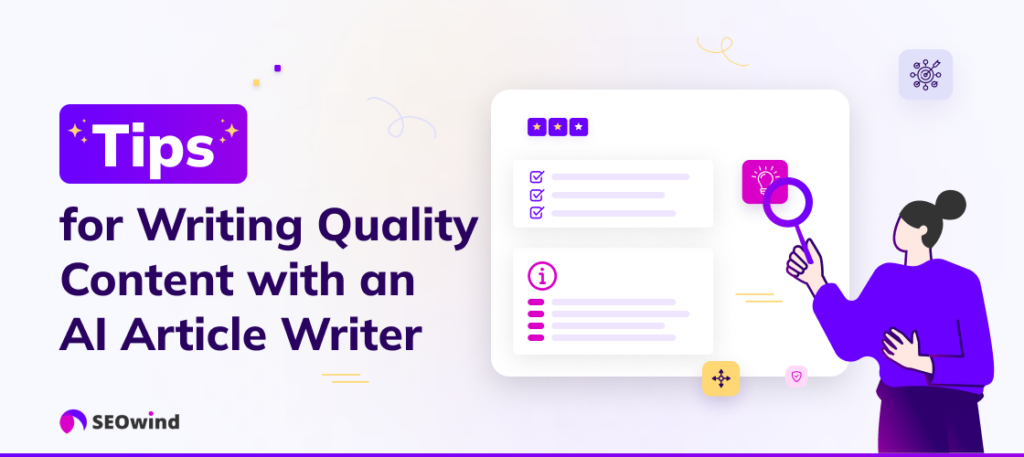
Creating quality content using AI-generated articles might seem challenging initially. As we venture into this innovative era, embracing technology wholeheartedly can be the key to success. Here are some noteworthy tips that you can employ when writing top-notch content with an AI article writer.
- Have a Clear Goal in Mind: Ensure the concept you want your AI to write articles about is precise. Providing explicit instructions will generate outstanding output quality.
- AI and Human Collaboration is Key: Even though autonomy is one of the core perks of AI automatic writing, an AI writes better when it has human assistance. Through collaboration, we can leverage the best of both worlds when humans offer creative thinking and judgment calls and Artificial Intelligence provides speed and precision.
- Regularly Update Your Subject Matter: Our world is constantly evolving. Therefore, updating your required subject matter promptly helps ensure that the content generated by your AI writer online remains relevant and refreshed.
- Emphasize Keywords: This plays a crucial role in optimizing your content for SEO purposes and giving clear guidance to your AI tool regarding what should be written about.
- Proofread the Content: Finally, always take time to proofread what AI writes for you. Even machines make errors sometimes. Review each piece to guarantee its coherence and clarity before publishing or sharing it with a broader audience.
A smoothly functioning partnership between Artificial Intelligence and mankind can bring significant innovation and growth in diverse fields, including content creation. With these tips, anyone can write articles with AI more effectively while still ensuring they retain their unique voice and style.
How does AI Generate Articles?

AI’s ability to generate articles, whether short posts or extended pieces of writing, is nothing short of revolutionary. Surprisingly, the process behind this remarkable innovation can be understood with relative ease. AI writes articles by drawing on a pool of information fed to it by humans and using complex algorithms to arrange that data into coherent sentences.
Step 1: Data Collection
Initially, AI needs vast amounts of data input to write articles. This could include existing online content such as blogs, books, websites, and research databases. The more diverse the input data, the better the output.
Step 2: Understanding Context
Once the necessary data is collected, it’s time for Natural Language Processing (NLP). A subfield of Artificial Intelligence, NLP is responsible for helping machines understand human language’s subtle nuances. Making a machine comprehend context is no mean feat.
Step 3: Generation & Refinement
After understanding the context, the next step is generating text, followed promptly by refining it. Algorithms known as generative models help achieve this purpose. Among them are transformer-based models like GPT-4 or BARD, which spin out grammatically correct and topically relevant content that virtually mimics a human-like writing style.
Step 4: Fine-tuning and Delivery
The final step involves fine-tuning and delivering the generated content based on specific guidelines and requirements. Reiterations may occur until the desired results are obtained, ensuring brand tone consistency.
In a nutshell, AI-powered writing demands extensive pre-training before deployment. But once primed and ready, the ability of these tools to create high-quality text quickly is worth every effort invested.
Conclusion: The Future of AI-Generated Articles
As we end this comprehensive discussion on AI-generated articles, it’s fair to say that AI has carved a niche within the content creation domain. Despite its nascent stage and potential hurdles, AI writing is equipped to conduct groundbreaking transformations in how we approach content.
Looking to the future, we can anticipate higher levels of sophistication and refinement in how Artificial Intelligence writes articles. We’re already experiencing real-time benefits such as speed in content generation, reduced human effort, and enhanced efficiency. Yet, this is merely scratching the surface. As machine learning evolves alongside Natural Language Processing (NLP) technologies, expect to see AI generate even more dynamic and personalized content that perfectly caters to every reader’s preferences.
Moreover, rather than posing a threat to human writers or taking away their livelihoods, as some tend to envisage, I see an immense opportunity for collaboration. Imagine what you could achieve when humans’ creative prowess is combined with AI’s ability to dissect massive amounts of data and translate it into meaningful narratives almost instantly – a formidable alliance indeed!
To ensure a seamless co-existence between humans and AI in article writing, it will be crucial for both parties to recognize each other’s strengths and use them complementarily. While the computer scripts may do well, replicating an AI writer online style guided by stringent SEO rules or defined structures like press releases, creative insights, or emotionally charged pieces is still too challenging.
Provided appropriate investment continues towards refining these intelligent tools in addition to conscious efforts for ethical usage, there’s no denying that Artificial Intelligence will become an even more integral part of our digital societies. It will facilitate enormous strides within article writing and across various sectors.
Whether you’re looking forward to writing articles with AI or curious about the potential, exercising caution as consumers of this technology is essential. No technology is perfect. AI-generated content also needs a thorough fact-check, proofreading, and context verification before usage.
With boundless potential and constant enhancements, it won’t be long before we find AI doing more than just assisting us. In the future, it will collaborate with us to redefine the boundaries of information exchange.
Frequently Asked Questions About AI-Generated Articles
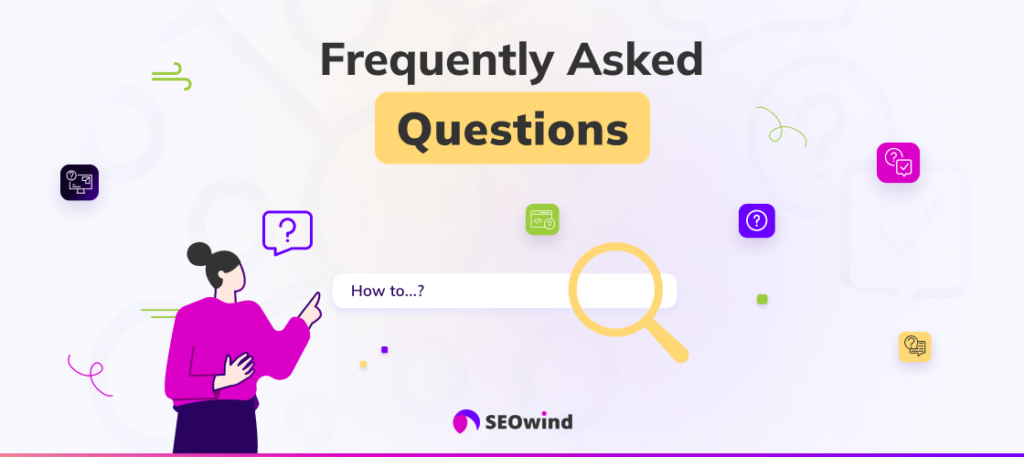
AI-generated articles are growing in popularity and, as such, garner a lot of inquiries from individuals and businesses alike. I’ll answer some of this topic’s most frequently asked questions here.
Can I post AI-generated articles?
Yes, you can undoubtedly post AI-generated articles. In fact, many online platforms are already utilizing these types of content for blog posts, SEO-focused material, product descriptions — even news updates! However, remember that this content still requires regular quality assurance checks before going live.
Can I use the AI-generated content on my blogging site?
Absolutely! Many bloggers use AI article writers like SEOwind or Jasper to increase their ability to produce quality content rapidly. With an appropriate level of modification and personal touch, which ensures the content aligns with your tone and brand, you can utilize AI-written articles seamlessly within your blog.
Is there an AI that can write articles for you?
Several impressive tools are available today that employ advanced algorithms capable of writing compelling and engaging articles. One prime example is SEOwind, which utilizes its own proprietary type of Artificial Intelligence to frame topics and rapidly generate high-quality written content. This resourcefulness makes it a solid choice for managing a heavy load of content creation.
The innovation does not end here, though. Other solutions, such as Jasper or Writesonic, offer similar capabilities to transform bullet-pointed ideas into fully-fledged blog posts or draft copies fit for various industrious purposes!
Leveraging these sophisticated tools should enhance your writing prowess, not completely replace the human touch! Your knowledge and AI’s speed and precision can make way for substantial growth in versatile business arenas.


